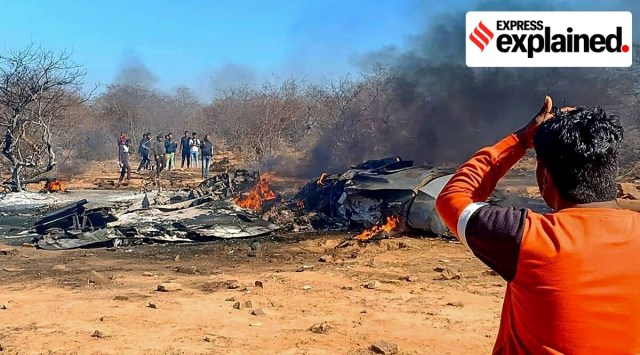Sukhoi, Mirage IAF jets crash: Possible mid-air collision, mission complex, wait for probe, say experts
Experts, including IAF veterans, told The Indian Express, that given the level of “complexity” in such advanced training missions and the skill-level of the pilots involved, it was hard to hazard a guess before the detailed inquiry is complete.
 Wreckage of the Mirage 2000 fighter plane that crashed near Morena in Madhya Pradesh, Saturday morning. The pilot did not survive the crash. PTI
Wreckage of the Mirage 2000 fighter plane that crashed near Morena in Madhya Pradesh, Saturday morning. The pilot did not survive the crash. PTI A Court of Inquiry has been set up to ascertain the cause of the crash of the two Indian Air Force (IAF) fighter jets, a Sukhoi 30 and a Mirage 2000, which killed an experienced pilot Saturday.
Experts, including IAF veterans, told The Indian Express, that given the level of “complexity” in such advanced training missions and the skill-level of the pilots involved, it was hard to hazard a guess before the detailed inquiry is complete.
Preliminary analysis of crash reports, they said, point to the possibility of a mid-air collision given the two aircraft taking off from the same air base, crashing around the same time and their debris being found in the same area.
“We do not know at what stage (the malfunction behind the crash) happened. Did they have contact and then the collision happened or was it from the word go? These are things that the inquiry will throw light on,” said an IAF veteran who is well-versed with combat training.
At the Tactics and Air Combat Development Establishment, he said, “highly advanced” combat manoeuvres are developed and taught. “The more complex the combat environment and manoeuvres, the higher the risk. It is not a benign situation,” the officer added.
“Having said that, such accidents are not usual. A lot of precautions, preparations and training takes place before such a complex training mission is undertaken.”
Anchit Gupta, an aviation historian told The Indian Express, that mid-air collisions though rare, have, historically, taken place during aerobatics, formation or close combat flying when the aircraft are required to fly very close to each other.
“Despite best efforts, the scope of error is minuscule,” he said, adding that risks are higher when large size formation and hard combat manoeuvres are being practised.
As per data compiled by Gupta, 62 aircraft have been lost to mid-air collisions in the Indian military in the last seven decades. These include 11 MiG-21s.
#WATCH | Wreckage seen. A Sukhoi-30 and Mirage 2000 aircraft crashed near Morena, Madhya Pradesh. Search and rescue operations launched. The two aircraft had taken off from the Gwalior air base where an exercise was going on. pic.twitter.com/xqCJ2autOe
— ANI (@ANI) January 28, 2023
“For the amount of flying IAF does, this is an exceptionally good safety record,” he said.
Former IAF fighter pilots explained that when it comes to mid-air collisions, a fighter aircraft operates in different circumstances than a civilian passenger aircraft. The last collision in civilian airspace took place in 1996 over Charkhi Dadri involving a Kazakh aircraft and a Saudi Arabia aircraft which killed 349 people.
A former Mirage 2000 pilot of the IAF told The Indian Express that in civil aviation, there are clear-cut guidelines to prevent a collision but in combat flying, the parameters are very different. “You want the aircraft to get close to the other, because you are attempting to shoot one another in a training exercise,” the pilot said. “You don’t actually fire a missile, but you go through the entire gamut of manoeuvres and learn the skill sets developed to shoot the enemy. If this is a transport aircraft, it is a simple kill, while if it is another fighter aircraft you get into combat in which you fight each other,” the officer said.
Also, in fighter flying, pilots are closing into each other at speeds in excess of 2,000 km per hour. “This means the reaction time is extremely low,” he said.






































